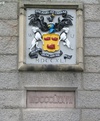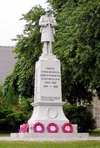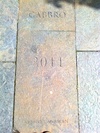| Kirkton of Bourtie Recumbent Stone Circle |
|---|

The remains of this recumbent stone circle are situated in a cultivated field and comprise the recumbent, the E flanker, and two stones on the W arc. All the stones are of granite, the recumbent measuring 5.1m in length by 1.9m in height and 1.7m in thickness. The E flanker measures 2.9m in height by 1.45m in breadth and 1m in thickness. A large void beneath the E end of the recumbent has been filled in antiquity with a large boulder. The erect stones on the WSW and WNW of the circle measure 1.7m and 2.2m in height respectively. RCAHMS |
| Meldrum Arms and a datestone |

Situated above the entrance to Old Meldrum town hall are a polychrome armorial plaque of the 'Meldrum Arms' modelled in high relief and bearing the date 1741 in Roman numerals, immediatley below is a datestone also in Roman numerals bearing the date 1877 More Information |
| Old Meldrum Sailor |

Near life size stone statue of a sailor in period costume holding a pipe in one hand and an anchor in the other. More Information |
| Old Meldrum War Memorial |

A kilted soldier type, light coloured stone war memorial almost identical to the one at Portsoy except for this one having a smooth dressed pediment. It commemorates the dead of both World War I & II. It is rectangular with a splayed base standing on a two-stepped plinth. It is surmounted with the statue of a kilted soldier with a Glengary bonnet, standing head bowed and holding an inverted rifle. More Information |
| The Eternal Present |

A sculpture consisting of three large spheres of granite, gneiss and gabbro; sourced from Aberdeenshire quarries. Carved in designs based on the enigmatic neolithic stone balls known as 'petrospheres' that are estimated to have been produced between 5,000 and 2,000 B. C. These neolithic objects, of hand holding size, and of unknown function are peculiar to Scotland (except for 1 Irish and 4 Northern English finds) and have been found in considerable number particularly in the North-east, currently 425 known . They are decorated with varied numbers of knobs or more precisely convex discs anything from 3 to 160. Perhaps the best known because one of the most highly decorated is the Towie Ball. See external link to NMS More Information |
This content was submitted by external contributors and does not necessarily reflect the views of the University of Aberdeen.
